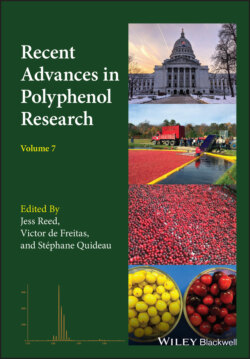Читать книгу Recent Advances in Polyphenol Research - Группа авторов - Страница 21
1.4.2 2‐Hydroxyflavylium Derivatives and Flavanones
ОглавлениеThe 2’‐hydroxyflavylium derivatives give rise to the formation of flavanones as shown in Scheme 1.11 and Figure 1.6 (Petrov et al. 2008; Slavcheva et al. 2018).
Figure 1.6 shows the spectral variations after a direct pH jump to pH=8.1 (Slavcheva, et al. 2018). A few seconds after the pH jump the anionic hemiketal and cis‐chalcone are formed (Figure 1.6a). The system evolves and gives the anionic trans‐chalcone after c. 40 minutes. However, equilibrium is reached four hours later, only after formation of the flavanone (FLV; Figure 1.6b), indicating that the flavanone is formed from the anionic trans‐chalcone. Acidification of the flavanone does not give any spectral variation, but basification to pH=12.0 very quickly gives Ct2‐ (kobs = 3.3 s‐1). When the titration of Ct2‐ by reverse pH jump is carried out, the absorption spectra of Ct‐ and Ct are observed according to the final pH. The spectrum of Ct is stable and the one of Ct‐ gives the flavanone as in Figure 1.6b.
Scheme 1.11 2’‐hydroxy‐5’‐methylflavylium and its derived flavanone form.
Figure 1.6 (a) Spectral variations after a direct pH jump from pH=1 to pH=8.1 of the compound 2’‐hydroxy‐5‐methylflavylium up to 40 minutes; (b) the same after 40 minutes up to 4 hours; (c) reverse pH jump from pH=12 to pH=8.4.
Source: Slavcheva, et al. 2018. © 2018 Elsevier.
This peculiar behavior permits to illustrate the concept of a timer at the molecular level with reset capacity (Scheme 1.12).
The initial species is Ct at pH=4.0. The activation of the timer is made by changing the pH to pH=8.0, which allows the flavanone formation to start. To stop the timer the pH is reversed back to pH=4.0. The unreacted Ct‐ immediately gives the stable Ct and the flavanone does not react. The flavanone/trans‐chalcone molar ratio gives the extension of the reaction and the elapsed time.7 To reset the timer two steps are needed: (i) the unlock step should be achieved by changing the pH to 12; the unreacted Ct and the flavanone (more precisely the anionic flavanone) give Ct2‐, and (ii) after the end of the first step, the pH is shifted to 4.0 and the reaction goes back to Ct.
Scheme 1.12 Illustrating the concept of a timer with reset capacity through a metamorphosis cycle.
Source: Slavcheva, et al. 2018. © 2018 Elsevier.
